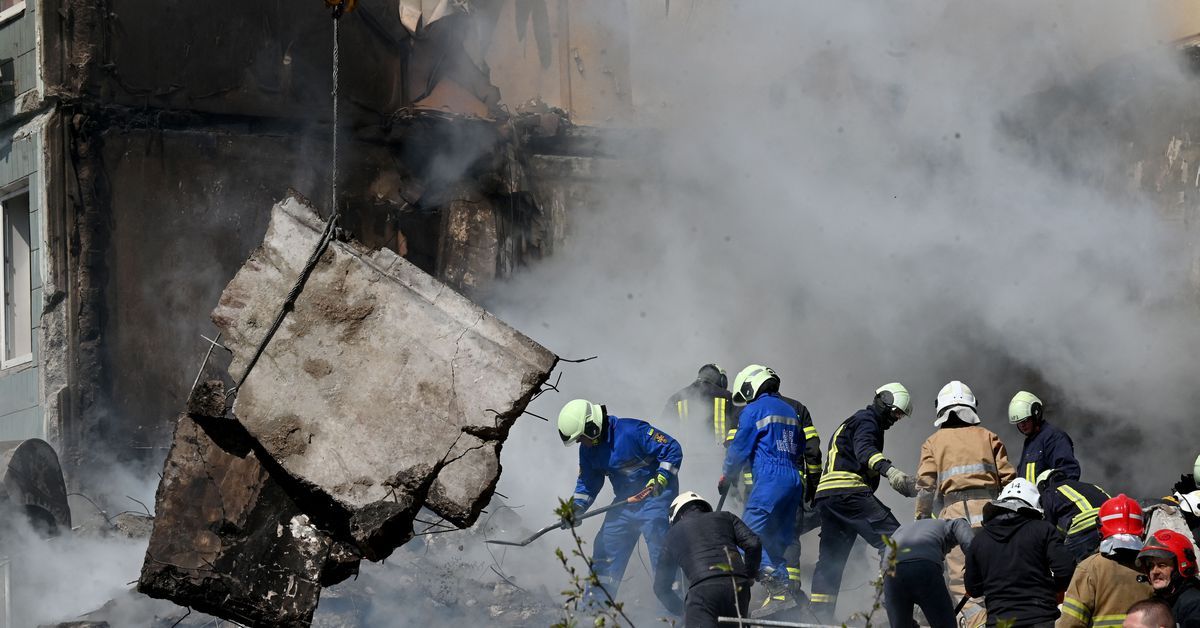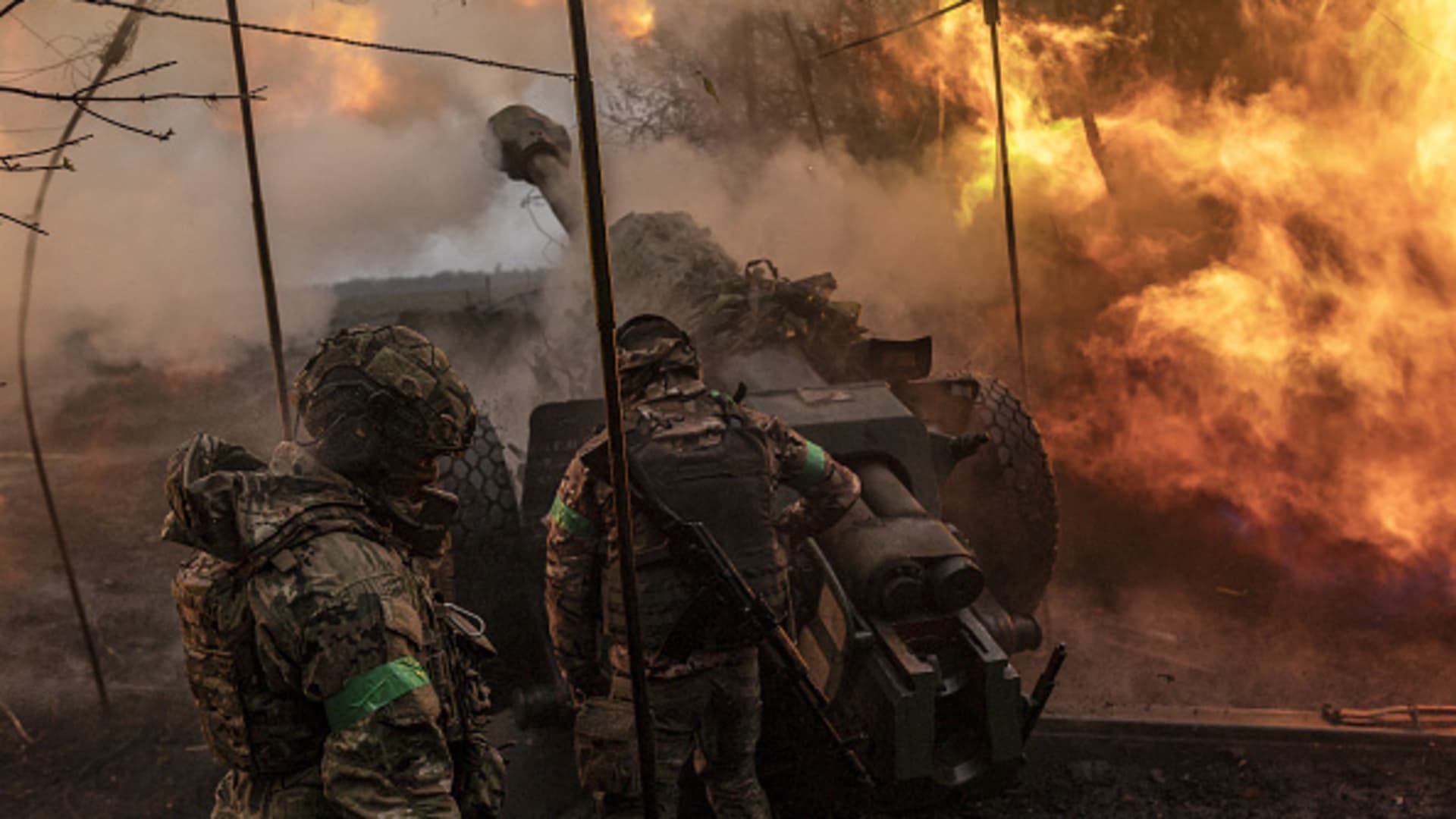Russia carries out another major airstrike against Ukraine
Russia unleashed an air barrage on Ukraine early Monday, the second all-out assault in about less than a week, which comes as Ukraine gears up for its spring counteroffensive.
Early Monday morning, Russia launched 18 Kh-101 and Kh-555 cruise missiles against Ukraine, though Ukrainian air defenses intercepted 15 of the 18, according to Ukrainian defense officials. At least 40 people, including five children, were wounded in Pavlograd, in the Dnipropetrovsk region, where officials said Russia struck dozens of buildings, including apartments and homes, schools, and shops. The attack followed a large-scale Russian strike on Friday where, in the city of Uman, at least 23 civilians, including six children, died after two cruise missiles struck an apartment building.
The attacks were the first major Russian precision aerial strikes across large swaths of Ukraine in many weeks. Last fall and winter, Russia unleashed a widespread air campaign against energy and civilian infrastructure, an effort to weaken Ukraine and deplete the morale of Ukrainian civilians. Moscow caused widespread damage but largely failed to achieve those objectives, and Kyiv’s Western backers responded by assisting Ukraine with Western air defense systems.
Russia’s renewed attacks are likely a sign that it is not just Kyiv but also Moscow that is preparing for a Ukrainian counteroffensive, as Kyiv seeks to reclaim Russian-occupied territory.
Ukraine has, naturally, not publicly announced the start time of that campaign, but Ukrainian defense officials have indicated that they’re ready for it. Kyiv has also apparently stepped up attacks in Russian-controlled territory, including blowing up an oil depot in Crimea over the weekend. Russia initiated its latest strike after that explosion, but it has also been fortifying its defenses for months — and it potentially seeks a more decisive victory before Kyiv goes on the attack.
A Ukrainian counteroffensive looms, for Ukraine, Russia, and the West
The Russian Ministry of Defense acknowledged the strikes Monday, saying it used “high-precision, long-range air and sea-based weapons against the objects of the military-industrial complex of Ukraine.” In the same Telegram post, the Ministry of Defense said it had achieved its goal, and that enterprises producing weapons and military equipment for Ukrainian forces were disrupted. The Guardian reports that railway infrastructure and an ammunition depot in southeastern Ukraine were potentially hit, though Ukrainian officials have not publicly confirmed. Civilian locations were also hit in the aerial attack on Monday, and officials also said strikes caused “significant damage” to power networks in Dnipro, in central Ukraine.
This destruction came after a relative lull in large-scale missile attacks. The timing likely has to do with Ukraine’s expected counteroffensive. Hanna Shelest, director of security programs at the Foreign Policy Council “Ukrainian Prism” and nonresident senior fellow at the Center for European Policy Analysis (CEPA), said that, based on the actions Russia has taken in recent weeks, it is “demonstrating the Russians are really preparing for the counteroffensive.”
These recent attacks, she added, are potentially Russia testing out and mapping Ukraine’s air defense systems ahead of the planned counteroffensive.
In mid-April, Patriot air defense systems arrived in Ukraine, one from the US and the other gifted from Germany and the Netherlands, after Ukrainian forces received rapid training on the systems. Western governments had already provided Ukraine other Western-made defense systems, including the US’s National Advanced Surface-to-Air Missile Systems (NASAMS).
But throughout the war, Ukraine has largely relied on old Soviet models, and stocks of the missiles used in those systems were running dangerously low, at least according to a February assessment in those leaked Pentagon documents. Western backers have provided additional air defense interceptors since, and now the Patriots have arrived. But Russia — which itself may not have unlimited supplies of long-range, precision missiles — may be trying to find vulnerabilities in Ukraine’s air defenses to exploit once Ukraine launches its offensive.
Russia’s aerial bombardment also came as Ukraine has made it pretty clear that it is preparing for its counteroffensive, including taking credit for a likely drone strike on a target in Russia-occupied Crimea, near where Russia’s Black Sea fleet is located. Though Ukraine has tended to avoid taking explicit responsibility for attacks behind lines of Russian control, a spokesperson for Ukraine’s southern command, Natalia Humeniuk, said the explosion was part of “the broad, full-scale offensive that everyone expects.” On Monday, an explosion derailed a freight train in Russia, in a region close to the Ukrainian border, though no one has claimed responsibility.
And fighting continues elsewhere along the front lines in Ukraine, specifically in Bakhmut, a battle in eastern Ukraine that has been raging for months. Both Ukraine and Russia have claimed to make gains in recent days.
On Monday, White House National Security Council spokesperson John Kirby said the US estimates that Russia has suffered 100,000 casualties since December, including 20,000 killed — an astounding figure, tied mostly to the months-long battle for Bakhmut. In Bakhmut, Russia relied on fighters from the private Wagner military group, using them as cannon fodder as they sought to take the city. Kirby did not confirm Ukrainian casualties, but it was a reminder of how brutal and bloody a battle Bakhmut has been — and why both Ukraine and Russia might be eager for a symbolic win in combat that has exhausted troops on both sides.
That need for victory may be even more pronounced in Russia, after its winter counteroffensive failed, at least at present, to achieve more than minor territorial gains. As Shelest pointed out, Russia could use a win before Ukraine goes on the attack, and it may specifically may want one before May 9 — “Victory Day” in Russia, which honors the country’s victory in World War II.
Though reports suggest it might be a scaled-down event, as the Kremlin has security concerns and maybe is a bit low on tanks to parade around, it is a significant day on the calendar, and one that Vladimir Putin will still likely mark in some fashion. Last year, Putin commemorated the day but avoided any huge declarations, despite some speculation that he might try to tie ramp up war efforts. But May 9 is here again, and it arrives alongside a potential new phase of war — and that always comes with a degree of unpredictability.
Source: Vox.com


